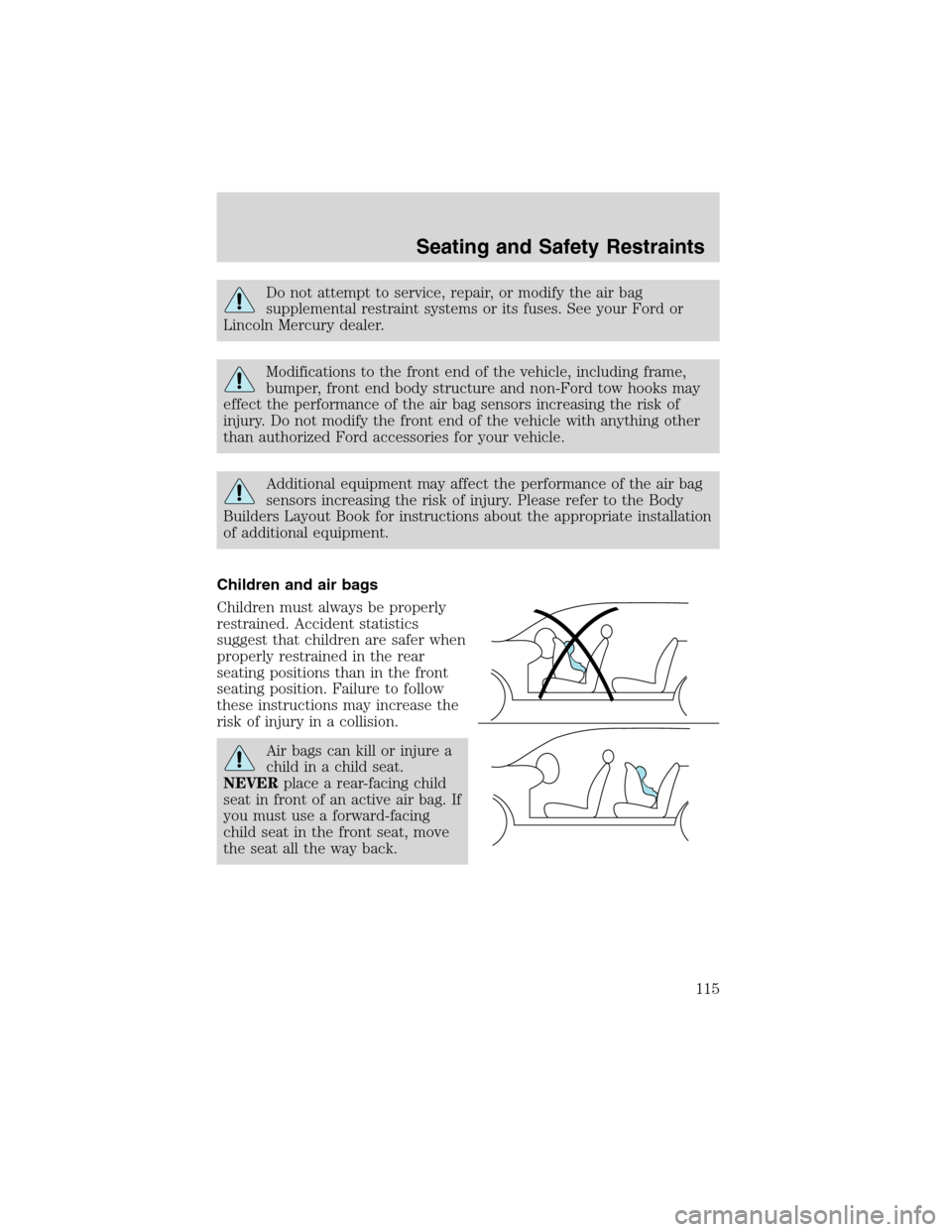Page 2 of 272
Driving 134
Starting 134
Brakes 137
Traction control/AdvanceTrac 139
Transmission operation 143
Trailer towing 169
Roadside Emergencies 176
Getting roadside assistance 176
Hazard flasher switch 177
Fuel pump shut-off switch 177
Fuses and relays 178
Changing tires 188
Jump starting 195
Wrecker towing 200
Customer Assistance 201
The dispute settlement board 203
Utilizing the mediation/arbitration 206
Getting assistance outside the U.S. and Canada 207
Ordering additional owner’s literature 208
Reporting safety defects (U.S. only) 209
Cleaning 210
Maintenance and Specifications 216
Engine compartment 219
Engine oil 221
Battery 227
Fuel information 235
Low tire warning system 252
Part numbers 254
Refill capacities 254
Lubricant specifications 257
Table of Contents
2
Page 8 of 272
These are some of the symbols you may see on your vehicle.
Vehicle Symbol Glossary
Safety Alert
See Owner’s Guide
Fasten Safety BeltAir Bag-Front
Air Bag-SideChild Seat
Child Seat Installation
WarningChild Seat Lower
Anchor
Child Seat Tether
AnchorBrake System
Anti-Lock Brake SystemBrake Fluid -
Non-Petroleum Based
Traction ControlAdvanceTrac
Master Lighting SwitchHazard Warning Flasher
Fog Lamps-FrontFuse Compartment
Fuel Pump ResetWindshield Wash/Wipe
Windshield
Defrost/DemistRear Window
Defrost/Demist
Introduction
8
Page 115 of 272

Do not attempt to service, repair, or modify the air bag
supplemental restraint systems or its fuses. See your Ford or
Lincoln Mercury dealer.
Modifications to the front end of the vehicle, including frame,
bumper, front end body structure and non-Ford tow hooks may
effect the performance of the air bag sensors increasing the risk of
injury. Do not modify the front end of the vehicle with anything other
than authorized Ford accessories for your vehicle.
Additional equipment may affect the performance of the air bag
sensors increasing the risk of injury. Please refer to the Body
Builders Layout Book for instructions about the appropriate installation
of additional equipment.
Children and air bags
Children must always be properly
restrained. Accident statistics
suggest that children are safer when
properly restrained in the rear
seating positions than in the front
seating position. Failure to follow
these instructions may increase the
risk of injury in a collision.
Air bags can kill or injure a
child in a child seat.
NEVERplace a rear-facing child
seat in front of an active air bag. If
you must use a forward-facing
child seat in the front seat, move
the seat all the way back.
Seating and Safety Restraints
115
Page 118 of 272
Safety Canopy�system (if equipped)
Do not place objects or
mount equipment on or
near the headliner at the siderail
that may come into contact with a
deploying Safety Canopy�. Failure
to follow these instructions may
increase the risk of personal injury
in the event of a collision.
Do not lean your head on the door. The Safety Canopy�could
injure you as it deploys from the headliner.
Do not attempt to service, repair, or modify the Safety Canopy�
system, its fuses, the A, B, or C pillar trim, or the headliner on a
vehicle containing a Safety Canopy�. See your Ford or Lincoln
Mercury dealer.
All occupants of the vehicle including the driver should always
wear their safety belts even when an air bag SRS and Safety
Canopy�system is provided.
To reduce risk of injury, do not obstruct or place objects in the
deployment path of the inflatable Safety Canopy�.
Seating and Safety Restraints
118
Page 144 of 272
3. Rotate the access panel
(counterclockwise) with a flat head
screw driver until it is lined up to
the access hole in the open position.
4. Insert a tool (or screw driver) into the access hole to override the
brake-shift interlock. Apply the brake and shift into Neutral.
5. Return the cover plate (rotate
clockwise) to the closed position.
Start the vehicle.
If it is necessary to use the above procedure to move the gearshift lever,
it is possible that a fuse has blown or the vehicle’s brakelamps are not
operating properly. Refer toFuses and relaysin theRoadside
emergencieschapter.
Do not drive your vehicle until you verify that the brakelamps
are working.
Driving
144
Page 178 of 272
The fuel pump shut-off switch is
located in the passenger’s foot well,
by the kick panel.
Use the following procedure to reset the fuel pump shut-off switch.
1. Turn the ignition to the OFF position.
2. Check the fuel system for leaks.
3. If no fuel leak is apparent, reset the fuel pump shut-off switch by
pushing in on the reset button.
4. Turn the ignition to the ON position. Pause for a few seconds and
return the key to the OFF position.
5. Make a further check for leaks in the fuel system.
FUSES AND RELAYS
Fuses
If electrical components in the
vehicle are not working, a fuse may
have blown. Blown fuses are
identified by a broken wire within
the fuse. Check the appropriate
fuses before replacing any electrical
components.
15
Roadside Emergencies
178
Page 179 of 272
Note:Always replace a fuse with one that has the specified amperage
rating. Using a fuse with a higher amperage rating can cause severe wire
damage and could start a fire.
Standard fuse amperage rating and color
COLOR
Fuse
ratingMini
fusesStandard
fusesMaxi
fusesCartridge
maxi
fusesFuse link
cartridge
2A Grey Grey———
3A Violet Violet———
4A Pink Pink———
5A Tan Tan———
7.5A Brown Brown———
10A Red Red———
15A Blue Blue———
20A Yellow Yellow Yellow Blue Blue
25A Natural Natural———
30A Green Green Green Pink Pink
40A——Orange Green Green
50A——Red Red Red
60A——Blue—Yellow
70A——Ta n—Brown
80A——Natural—Black
Roadside Emergencies
179
Page 180 of 272
Passenger compartment fuse panel
The fuse panel is located below the
instrument panel on the driver’s
side.
To remove a fuse use the fuse puller tool provided on the fuse panel box.
161621 26
27
28
29
30 22
23
24
25 17
18
19
20 7
8
9
10
11
12
13
14
15 2
3
4
5
Roadside Emergencies
180